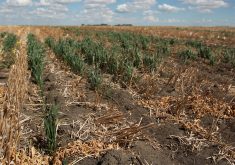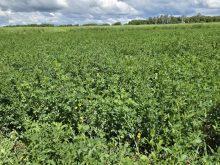Agricultural insurance rates across the Prairies will be going up this year as a result of higher commodity prices and huge payouts following last year’s drought.
Darryl Kay, chief executive officer of the Agriculture Financial Services Corporation (AFSC), said an increase in AgriInsurance premiums by 10 percent on average is mainly driven by the rise in crop prices. Prices for barley and wheat have risen by 25 and 40 percent, respectively.
However, there is a flipside to that rise.
“The good news is coverage levels are going up significantly for producers,” said Kay. “On average, the coverage is going from $365 to up to over $500 (per acre).”
Read Also

Research looks to control flea beetles with RNAi
A Vancouver agri-tech company wants to give canola growers another weapon in the never-ending battle against flea beetles.
While insurance rates are different for each producer, this year’s premium rate increase will be capped at 10 percent. Dollar coverage on annual crops will be going up 37 percent on average with pasture and hay seeing a 15 percent increase.
The payouts from the drought-plagued 2021 took a chunk out of AFSC’s reserves as well, added Kay, necessitating the premium rise to keep that fund sustainable.
“The latest estimates I’ve seen is that we’re going to pay out $2.2 billion in insurance claims for the drought we went through — almost a third of that relates to our variable price benefit, which I think really helped producers.”
The AFSC’s crop fund sits at between $600 and $700 million, which Kay said is necessary to maintain stability of the service.
Kay said year-over-year premium hikes are capped and AFSC is aware of the higher input costs being faced by farmers and ranchers across the board.
The Alberta Premium Reduction discount, which helped producers save on insurance rates, will not be available for 2022.
Kay said AFSC’s financial position going into 2021 allowed for that premium discount to continue through last year but that isn’t the case this year.
“Obviously, in the financial position we were in (in 2021), sitting on a surplus of almost $2.7 billion, we were able to offer the 20 percent discount and saved producers over $70 million,” said Kay. “But it was always subject to an annual review.”
With those reserves dropping by more than $2 billion in payouts in 2021, Kay said AFSC would not offer the discount this year.
AFSC has changed its Moisture Deficiency insurance program to make it more responsive.
“We talked to producers in the fall, we listened and we made some changes there to build in a heat index to change how we calculate some of the minimums.”
Kay said it’s important for ranchers and farmers to contact AFSC to figure out an insurance plan for individual agricultural operations.
“Every producer’s situation is different,” he said. “We encourage them to reach out to one of our branches and speak to our teams there and we can help with that discussion.”
Manitoba and Saskatchewan are expected to initiate premium hikes.
Manitoba will see premiums rise from $9.16 per acre in 2021 to $14.49 with dollar coverage up by 40 percent.
In Saskatchewan, the average premium increase per acre will be going up from $8.59 per acre to $12.05.


















